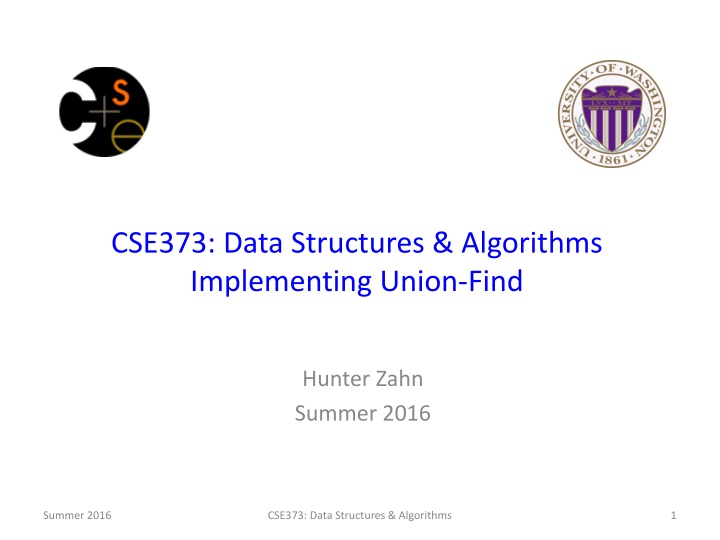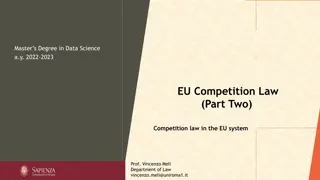Implementing Union-Find Data Structure
Dive into the principles and applications of the union-find abstract data type for disjoint sets. Explore the basic implementation with up trees and optimizations to enhance efficiency. Grasp the operations involved, such as find and union, and understand their impact on set partitions. Discover the goal of achieving amortized constant time complexity and visualize the data structure's representation for better comprehension.
Download Presentation

Please find below an Image/Link to download the presentation.
The content on the website is provided AS IS for your information and personal use only. It may not be sold, licensed, or shared on other websites without obtaining consent from the author.If you encounter any issues during the download, it is possible that the publisher has removed the file from their server.
You are allowed to download the files provided on this website for personal or commercial use, subject to the condition that they are used lawfully. All files are the property of their respective owners.
The content on the website is provided AS IS for your information and personal use only. It may not be sold, licensed, or shared on other websites without obtaining consent from the author.
E N D
Presentation Transcript
CSE373: Data Structures & Algorithms Implementing Union-Find Hunter Zahn Summer 2016 Summer 2016 CSE373: Data Structures & Algorithms 1
Announcements HW3 due tomorrow at 11PM Remember, you re not merging WordInfos! Midterm Friday! Midterm Review in-class Wednesday No TA Review session Thursday No Office hours Friday post-midterm We ll be busy grading your exams Summer 2016 CSE373: Data Structures & Algorithms 2
The plan Last lecture: What are disjoint sets And how are they the same thing as equivalence relations The union-find ADT for disjoint sets Applications of union-find Now: Basic implementation of the ADT with up trees Optimizations that make the implementation much faster CSE373: Data Structures & Summer 2016 3 Algorithms
Review: ADT Operations Given an unchanging set S, create an initial partition of a set Typically each item in its own subset: {a}, {b}, {c}, Give each subset a name by choosing a representative element Operation find takes an element of S and returns the representative element of the subset it is in Operation union takes two subsets and (permanently) makes one larger subset A different partition with one fewer set Affects result of subsequent find operations Choice of representative element up to implementation CSE373: Data Structures & Summer 2016 4 Algorithms
Our goal Start with an initial partition of n subsets Often 1-element sets, e.g., {1}, {2}, {3}, , {n} May have mfind operations and up to n-1 union operations in any order After n-1 union operations, every find returns same 1 set If total for all these operations is O(m+n), then amortized O(1) We will get very, very close to this O(1) worst-case is impossible for findandunion Trivial for one or the other CSE373: Data Structures & Summer 2016 5 Algorithms
How should we draw this data structure? Saw with heaps that a more intuitive depiction of the data structure can help us better conceptualize the operations. Summer 2016 CSE373: Data Structures & Algorithms 6
Up-tree data structure Tree with: No limit on branching factor References from children to parent Start with forest of 1-node trees 1 2 3 4 5 6 7 Possible forest after several unions: Will use roots for set names 7 1 3 5 4 2 6 CSE373: Data Structures & Summer 2016 7 Algorithms
Find find(x): Assume we have O(1) access to each node Start at x and follow parent pointers to root Return the root find(6) = 7 3 7 1 5 4 2 6 CSE373: Data Structures & Summer 2016 8 Algorithms
Union union(x,y): Assume x and y are roots If they are not, just find the roots of their trees Assume distinct trees (else do nothing) Change root of one to have parent be the root of the other Notice no limit on branching factor union(1,7) 1 3 7 2 5 4 CSE373: Data Structures & Summer 2016 9 Algorithms 6
Okay, how can we represent it internally? Summer 2016 CSE373: Data Structures & Algorithms 10
Simple implementation If set elements are contiguous numbers (e.g., 1,2, ,n), use an array of length n called up Starting at index 1 on slides Put in array index of parent, with 0 (or -1, etc.) for a root Example: 1 2 3 4 5 6 7 5 6 4 1 2 3 7 0 0 0 0 0 0 0 up 1 2 3 4 5 6 7 1 3 7 0 1 0 7 7 5 0 up 5 4 2 6 If set elements are not contiguous numbers, could have a separate dictionary to map elements (keys) to numbers (values) Summer 2016 CSE373: Data Structures & Algorithms 11
Implement operations // assumes x in range 1,n int find(int x) { while(up[x] != 0) { x = up[x]; } return x; } // assumes x,y are roots void union(int x, int y){ // y = find(y) // x = find(x) up[y] = x; } Worst-case run-time for union? Worst-case run-time for find? Worst-case run-time for mfinds and n-1 unions? CSE373: Data Structures & Summer 2016 12 Algorithms
Implement operations // assumes x in range 1,n int find(int x) { while(up[x] != 0) { x = up[x]; } return x; } // assumes x,y are roots void union(int x, int y){ // y = find(y) // x = find(x) up[y] = x; } Worst-case run-time for union? Worst-case run-time for find? Worst-case run-time for mfinds and n-1 unions? O(1) (with our assumption ) O(n) O(m *n) CSE373: Data Structures & Summer 2016 13 Algorithms
The plan Last lecture: What are disjoint sets And how are they the same thing as equivalence relations The union-find ADT for disjoint sets Applications of union-find Now: Basic implementation of the ADT with up trees Optimizations that make the implementation much faster CSE373: Data Structures & Summer 2016 14 Algorithms
Two key optimizations 1. Improve union so it stays O(1) but makes find O(logn) 1. Improve find so it becomes even faster CSE373: Data Structures & Summer 2016 15 Algorithms
Two key optimizations 1. Improve union so it stays O(1) but makes find O(logn) So mfinds and n-1 unions is O(m logn + n) Union-by-size: connect smaller tree to larger tree 2. Improve find so it becomes even faster Make mfinds and n-1 unions almostO(m + n) Path-compression: connect directly to root during finds n = # of elements CSE373: Data Structures & Summer 2016 16 Algorithms
The bad case to avoid union(2,1) 1 2 3 n union(3,2) 2 3 n : . 1 3 n union(n,n-1) 2 n find(1) n steps!! 1 3 2 1 CSE373: Data Structures & Summer 2016 17 Algorithms
Weighted union Weighted union: Always point the smaller (total # of nodes) tree to the root of the larger tree union(1,7) 1 3 7 2 1 4 2 5 4 6 CSE373: Data Structures & Summer 2016 18 Algorithms
Weighted union Weighted union: Always point the smaller (total # of nodes) tree to the root of the larger tree union(1,7) 1 3 7 6 1 2 5 4 6 CSE373: Data Structures & Summer 2016 19 Algorithms
Weighted union Weighted union: Always point the smaller (total # of nodes) tree to the root of the larger tree union(1,7) 7 3 6 1 5 4 1 6 2 Summer 2016 CSE373: Data Structures & Algorithms 20
Weighted union What happens if we point the larger tree to the root of the smaller tree? Summer 2016 CSE373: Data Structures & Algorithms 21
Array implementation Keep the weight (number of nodes in a second array) Or have one array of objects with two fields 3 7 1 4 1 2 3 4 5 6 7 1 2 0 2 1 0 7 7 5 0 up 5 4 1 4 weight 2 6 1 2 3 4 5 6 7 3 7 1 6 7 2 1 0 7 7 5 0 up 1 1 6 weight 5 4 2 CSE373: Data Structures & Summer 2016 22 6 Algorithms
Nifty trick Actually we do not need a second array Instead of storing 0 for a root, store negation of weight So up value < 0 means a root 1 3 1 4 5 7 4 1 2 3 4 5 6 7 2 0 2 1 0 7 7 5 0 up 1 4 weight 2 6 1 2 3 4 5 6 7 3 7 1 6 7 2 1 0 7 7 5 0 up 1 1 6 weight 5 4 2 CSE373: Data Structures & Summer 2016 23 6 Algorithms
Bad example? Great example union(2,1) 1 2 3 n union(3,2) : 2 3 n 1 union(n,n-1) 2 n 1 3 2 find(1) constant here 1 3 n CSE373: Data Structures & Summer 2016 24 Algorithms
General analysis Showing that one worst-case example is now good is not a proof that the worst-case has improved So let s prove: union is still O(1) this is fairly easy to show find is now O(logn) Claim: If we use weighted-union, an up-tree of height h has at least 2h nodes Proof by induction on h CSE373: Data Structures & Summer 2016 25 Algorithms
Exponential number of nodes P(h)= With weighted-union, up-tree of height h has at least 2h nodes Proof by induction on h Base case: h = 0: The up-tree has 1 node and 20= 1 Inductive case: Assume P(h) and show P(h+1) A height h+1 tree T has at least one height h child T1 T1 has at least 2h nodes by induction And T has at least as many nodes not in T1 than in T1 Else weighted-union would have had T point to T1, not T1 point to T (!!) So total number of nodes is at least 2h + 2h = 2h+1 T h . T1 CSE373: Data Structures & Summer 2016 26 Algorithms
The key idea Intuition behind the proof: No one child can have more than half the nodes T h T1 So, as usual, if number of nodes is exponential in height, then height is logarithmic in number of nodes So find is O(logn) CSE373: Data Structures & Summer 2016 27 Algorithms
The new worst case n/2 Weighted Unions n/4 Weighted Unions CSE373: Data Structures & Summer 2016 28 Algorithms
The new worst case (continued) After n/2 + n/4 + + 1 Weighted Unions: logn Worst find Height grows by 1 a total of logn times CSE373: Data Structures & Summer 2016 29 Algorithms
What about union-by-height We could store the height of each root rather than number of descendants (weight) Still guarantees logarithmic worst-case find Proof left as an exercise if interested But does not work well with our next optimization Maintaining height becomes inefficient, but maintaining weight still easy CSE373: Data Structures & Summer 2016 30 Algorithms
Two key optimizations 1. Improve union so it stays O(1) but makes find O(logn) So mfinds and n-1 unions is O(m logn + n) Union-by-size: connect smaller tree to larger tree 2. Improve find so it becomes even faster Make mfinds and n-1 unions almostO(m + n) Path-compression: connect directly to root during finds CSE373: Data Structures & Summer 2016 31 Algorithms
Path compression Simple idea: As part of a find, change each encountered node s parent to point directly to root Faster future finds for everything on the path (and their descendants) 7 find(3) 1 7 1 5 2 3 6 5 4 4 2 11 12 10 9 8 6 8 9 3 10 CSE373: Data Structures & Summer 2016 32 Algorithms 11 12
Solution // performs path compression find(i) // find root r = i whileup[r] > 0 r = up[r] (good exampleof psuedocode!) // compress path if i == r return r old_parent = up[i] while (old_parent != r) up[i] = r i = old_parent old_parent = up[i] return r CSE373: Data Structures & Summer 2016 33 Algorithms
So, how fast is it? A single worst-case find could be O(logn) But only if we did a lot of worst-case unions beforehand And path compression will make future finds faster Turns out the amortized worst-case bound is much better than O(logn) We won t prove it see text if curious But we will understand it: How it is almostO(1) Because total for mfinds and n-1 unions is almostO(m+n) CSE373: Data Structures & Summer 2016 34 Algorithms
A really slow-growing function log*(x) is the minimum number of times you need to apply log of log of log of to go from x toa number <= 1 For just about every number we care about, log*(x) is 5 (!) If x <= 265536 then log*x <= 5 log* 2 = 1 log* 4 = log* 22 = 2 log* 16 = log* 2(22) = 3 (log(log(log(16))) = 1) log* 65536 = log* 2((22)2) = 4 (log(log(log(log(65536)))) = 1) log* 265536= = 5 CSE373: Data Structures & Summer 2016 35 Algorithms
Wait. how big? Just how big is 265536 Well 210 = 1024 220 = 1048576 230 = 1073741824 2100 = 1.125x1015 265536 = ... pretty big But its still not technically constant CSE373: Data Structures & Summer 2016 36 Algorithms
Almost linear Turns out total time for mfinds and n-1 unions is: O((m+n)*(log* (m+n)) Remember, if m+n < 265536 then log* (m+n) < 5 At this point, it feels almost silly to mention it, but even that bound is not tight Inverse Ackerman s function grows even more slowly than log* Inverse because Ackerman s function grows really fast Function also appears in combinatorics and geometry For any number you can possibly imagine, it is < 4 Can replace log*with Inverse Ackerman s in bound CSE373: Data Structures & Summer 2016 37 Algorithms
Theory and terminology Because log*or Inverse Ackerman s grows so incredibly slowly For all practical purposes, amortized bound is constant, i.e., total cost is linear We say near linear or effectively linear Need weighted-union and path-compression for this bound Path-compression changes height but not weight, so they interact well As always, asymptotic analysis is separate from coding it up CSE373: Data Structures & Summer 2016 38 Algorithms
Exam Topics Everything we ve covered, up through this lecture is fair game AVL Tree problem incoming! Good luck studying! Summer 2016 CSE373: Data Structures & Algorithms 39























